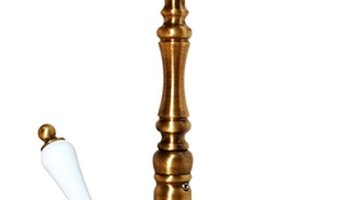Why Are There White Marks on My Granite Near the Faucet?
The appearance of white marks around a faucet on an expensive granite countertop can be worrisome for a number of reasons. You may wonder what's causing the marks, if you'll be able to remove them and if they'll permanently damage the granite. The marks can be removed, and steps can be taken to prevent them from returning.
Cause

The white marks are usually slightly chalky or cloudy in appearance, and over time they will build up and have a slight crustiness. They are caused by mineral deposits in the water. The water that produces these deposits is called "hard" because of the amount of calcium, lime and other minerals it contains. The water drips or splashes onto the counter from the faucet, and after it dries, the mineral residue is left behind.
Removal
The white marks are removable, but great care must be taken to use only gentle pressure and gentle chemicals so that the granite is not harmed. A razor blade can be used to scrape off any build up, as long as small, light strokes are used. White vinegar will remove the remaining stain, but it should not be left on the granite very long.
Daily Maintenance
The easiest way to prevent the buildup of the white marks is to wipe off the granite around the faucet and the faucet itself after you are finished using it. That will prevent minerals from depositing as water evaporates.
Commercial Cleaners and Sealers
After white marks are removed from the granite, they will not form again easily if the granite is regularly cleaned with a commercial granite cleaner. It will help to break down the minerals and provide a light coat that future minerals will not easily adhere to. If the white marks penetrate into the granite and are difficult to remove or to keep from reforming even with a commercial cleaner, it is time to reseal the granite.
Eliminate Hard Water
If the home has very hard water, not only is it forming buildups on the granite countertops, but it is doing the same inside the water heater and water pipes throughout the home. Installing a water softener can alleviate this problem.
Writer Bio
J.M. Pence has written magazine articles and essays for a variety of publications, including “Sunset,” “Mystery Scene,” “Cat Fancy,” and “Idaho Magazine,” plus 15 novels, a novella, and several short stories. Published since 1987, Pence holds a master's degree in journalism and a B.A. in history with a minor in political science from U.C. Berkeley.
Photo Credits
- copper faucet image by terex from Fotolia.com
More Articles



